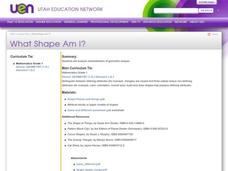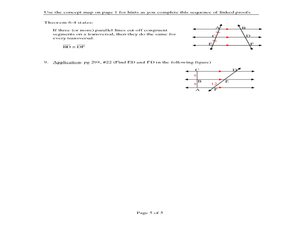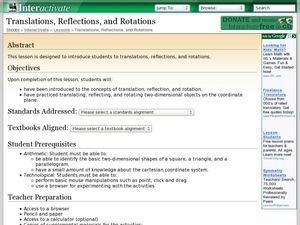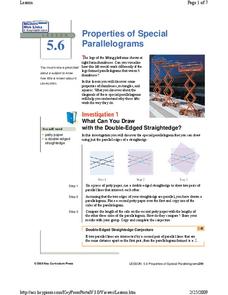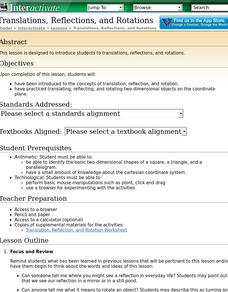Curated OER
The Truth About Triangles And Proofs
High schoolers engage in a lesson that is about the classification of triangles and the mathematical proofs involved in working with them. They work on a variety of problems that are created by the teacher with the focus upon the...
Curated OER
Angle Exploration and Classification
Students compare and contrast angles and identify them as acute, obtuse, right, or straight angles. They create rays and angles using uncooked spaghetti, read and discuss key vocabulary terms, and complete a variety of geometry worksheets.
Curated OER
Properties of Special Quadrilaterals
Teach your mathematicians how to identify the properties of quadrilaterals. In this geometry lesson, high schoolers solve for missing angles and sides of a special quadrilateral. They use the TI to move the sides around and create...
Curated OER
What Shape am I?
Students analyze characteristics of geometric shapes. They find shapes in their environment, and communicate why it is like the shape of their choice and not like another shape.
Curated OER
What Shape Am I?
First graders analyze characteristics of geometric shapes. They identify, describe, and create simple geometric figures. They analyze characteristics of geometric shapes and determine the defining attributes of a circle,...
Curated OER
Regular Polyhedra
Tenth graders investigate the history of geometry and its different shapes. In this geometry lesson, 10th graders practice seeing three dimensional shapes and explain why there are only five polyhedra. They relate all the new materials...
Curated OER
Logical Relationship of Postulates & Theorems
In this postulates and theorems instructional activity, students explore a concept map containing information about angles and sides, alternate interior angles, and diagonals of a parallelogram. They use the concept map to prove...
Curated OER
Vocabulary Challenge
In this math vocabulary worksheet, students choose which multiple choice answer best defines twenty-five mathematical terms. Students place their answers on the lines provided.
Curated OER
Problem-Solving Strategy: Find a Pattern
In this tessellations worksheet, students solve 2 word problems where they use the "make a pattern strategy" to form tessellations from geometric shapes. There is scaffolding for the problem solving strategy.
Curated OER
Translations, Reflections and Rotations
Fifth graders use the Internet to learn about translations, reflections and rotations. Students access the Transmographer program on the Internet, where they practice what they have learned. Students also complete a worksheet.
Curated OER
Geometry: Tessellations
Learners create tessellations with computer software while applying their knowledge of reflections, rotations, and translations.
Curated OER
Toothpicks, Gumdrops, and Polyhedrons
Sixth graders use toothpicks and gumdrops to make prisms and pyramids. This helps them explore the relationship betweeen faces, vertices, and edges.
Curated OER
Pent-up Pentominoes
Students explore pentominoes in this activity. They build shapes as directed and color the tiles on their grid sheet.
Curated OER
Parallel and Perpendicular Lines
Tenth graders explore parallel and perpendicular lines. In this geometry lesson, 10th graders investigate the relationships associated with parallel lines and transversals, perpendicular lines, and the angles formed by these...
Key Curriculum Press
Properties of Special Parallelograms
Rhombuses, rectangles and squares are have special properties. In this lesson, young geometers investigate and make conjectures about diagonals, angles, and parallel lines of parallelograms.
Curated OER
Quadrilaterals
In this geometry worksheet, 10th graders solve problems with quadrilaterals. They calculate the sum of the angles, find missing angles and identify properties of quadrilaterals. There are 16 questions with an answer key.
Curated OER
Dilations of 2 and 3 dimentional figures and their effect on area, surface area, and volume.
Seventh graders investigate the area and volume of 2D and 3D figures. In this geometry lesson, 7th graders create a storyboard explaining their knowledge of 2D and 3D shapes. They analyze their data and interpret their...
Curated OER
Tessellations
Students identify shapes that will tessellate. They construct a tessellation using transformations. Students identify transformations in tessellations. They identify applications of transformations such as tiling and fabric design.
Curated OER
Lengths, Areas and Shapes - Week 9
In this lengths, areas and shapes worksheet, students explore overlapping and non-overlapping patterns. They identify the number of objects in a pattern, determine how the pattern may be folded to create additional patterns, and...
Curated OER
Dilations- What a Stretch!
High schoolers perform dilation on various geometric shapes. They also discuss pros and cons of dilation and employ the Frayer Model to study the vocabulary words in this section.
Curated OER
Making Pictures from Smaller Shapes
Students investigate shapes. In this dimension and orientation of shapes lesson, students identify and color shapes, use shape stamps to form animals, glue shapes together to make other objects and describe how shapes are used.
Curated OER
Translations, Reflections, and Rotations
Tenth graders have been introduced to the concepts of translation, reflection, and rotation, and have practiced translating, reflecting, and rotating two-dimensional objects on the coordinate plane.
Curated OER
Exploring the Properties of Rectangular Prisms.
Students define properties of rectangular prisms. In this geometry lesson, students identify the relationship between two and three dimensional objects. They use Cabri technology to graph their figures.
Curated OER
An Introduction to Quadrilaterals
Students explore different types of quadrilaterals. Students define the terminology used with quadrilaterals. They create particular quadrilaterals based on specific characteristics of the quadrilaterals using an online tool.
Other popular searches
- Similar Congruent Polygons
- Naming Congruent Polygons
- Congruent Polygons Symmetry
- Congruent Polygons 3rd Grade
- Congruent Polygons Quilt
- Similar and Congruent Polygons






